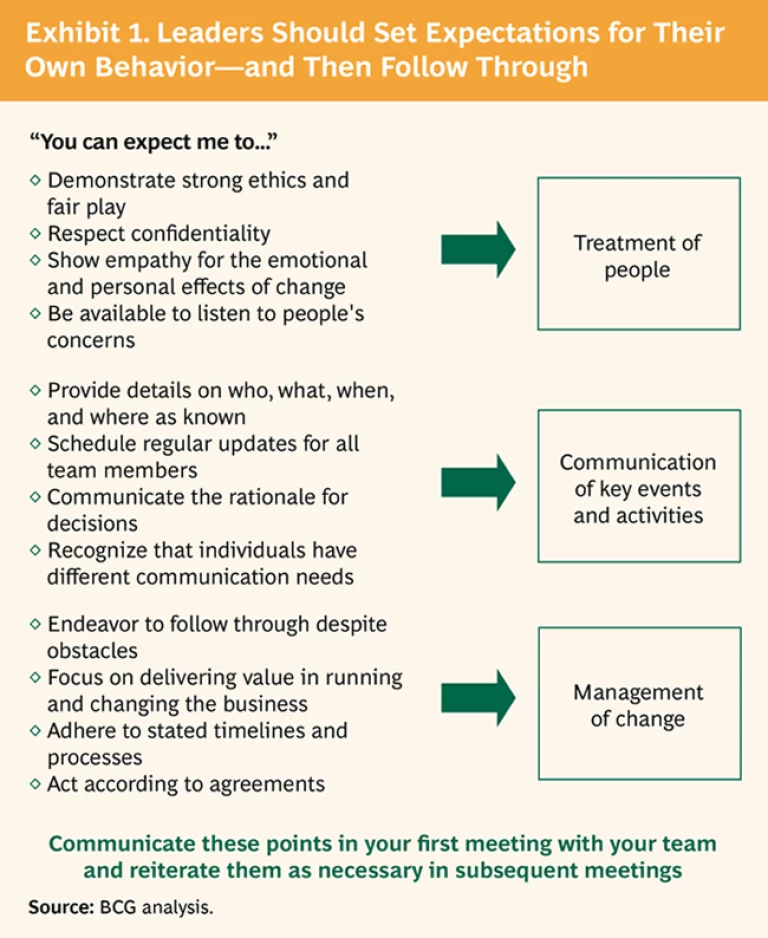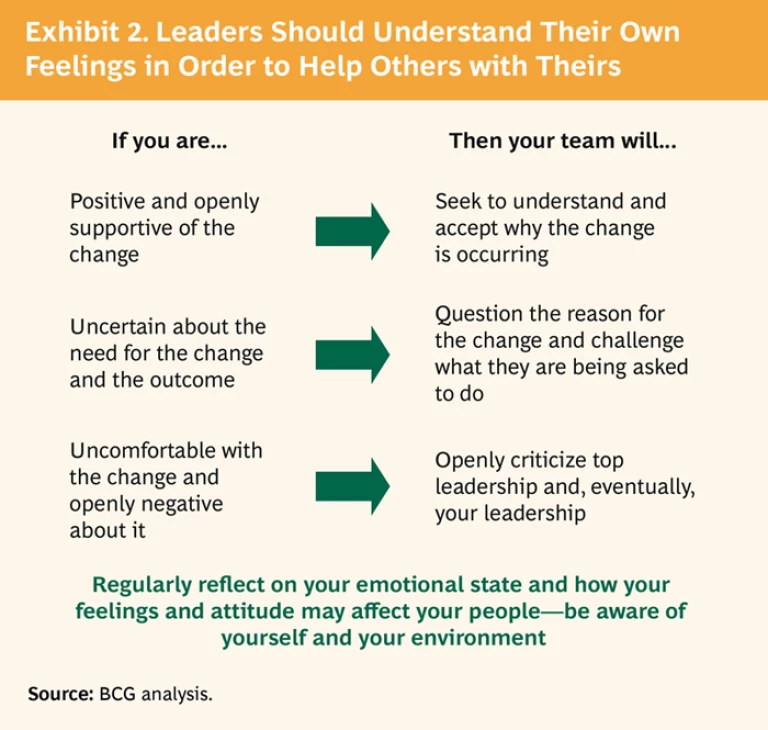Fundamental change is painful. The intellectual and logistical challenges may be daunting, but the emotional confusion and chaos created during such change can virtually paralyze an organization. In today’s turbulent environment, however, change is not optional. Financial markets are in turmoil, unemployment is rising in many countries, consumer and business confidence is declining, and economic uncertainty is rampant. These shifts are causing companies to deeply rethink their strategies, structures, and priorities. While major change may energize some employees, most find it unsettling—especially when accompanied by cost cuts, ownership changes, dramatic layoffs, or bankruptcy. The toll of uncertainty, grief, guilt, and anger can create major distress and can drastically undermine the change effort itself.
Farsighted leaders, however, endeavor to use times like these to sprint past their less nimble competitors.
Respect and Mobilize the Extended Leadership Team
You are not alone as a leader. As much as possible, bring in your broader leadership group to understand the challenges, participate in the planning, and cascade the changes throughout the organization. There is power in numbers. The members of a broader team will provide complementary skills and multiply the manpower and brainpower available to tackle critical issues.
Senior leaders often worry that difficult pending changes, if leaked, will paralyze the organization, so they opt for secrecy. As a result, midlevel and upper-midlevel leaders may hear major announcements only hours—or even minutes—before their teams and then are expected to pick up the pieces. These leaders almost invariably feel responsible for and take pride in their people. They have often been with the organization longer than the more senior leaders. Many of them are capable of brilliantly navigating their teams through turbulence, if they have advance (and confidential) notice of the changes—and even if they themselves may not have a future within the organization. By respecting, trusting, and properly engaging the broader leadership team, you also set a positive example for how these leaders should treat one another and your customers—whose loyalty is crucial in difficult times.
When business realities limit the number of people who can be “in the know” prior to particularly difficult announcements, it is imperative to have a process to rapidly engage with the extended leadership team immediately after the announcement and do everything possible to support them. Fully clarify the situation and what it means going forward, and explain why it was important to maintain secrecy. Don’t expect these discussions to be easy, but they are essential.
None of this happens accidentally. In order to properly mobilize managers, companies should devote a day or two to thoughtfully planned, formal training with each leadership level so that everyone knows his or her role and feels equipped to carry it out. Without a structured approach, it is very difficult to align the 50 to 500 leaders, depending on the size of the organization, who will drive a major change. Good intentions are not sufficient. Consistency of intent, execution, and communication is required
Set Clear Expectations for Your Team and Yourself
Provide clarity about the most critical elements of the change by explicitly spelling out the implications and your expectations for your team. Reducing avoidable ambiguity can increase morale and soften distracting emotions. Consider selectively killing or postponing nonessential projects, and recognize the value of making symbolic changes. Your team may need to defer or reduce its noncore and discretionary responsibilities in order to accomplish the heavy lifting associated with major change. Focus people on doing only what is necessary to win by deploying a “stop or skinny down” methodology for assessing current workloads. Be clear about what people can expect from their leaders and ensure that these expectations are communicated throughout the organization—and that they are met. (See Exhibit 1.)
Be Human—Be Real
Employees want to know that their leaders have a heart. People will rarely go the extra mile for someone who is all logic and no emotion—especially during difficult times. Be prepared to openly share with your team what the change means for you personally. This requires an honest evaluation of your feelings and the willingness—even the courage—to let your guard down. Your tone and delivery can and will influence how your people interpret and internalize the coming changes, so pay attention to both the content and the context of your messages. (See Exhibit 2.)
To deliver the support your team needs, both emotional and operational, you must be available to them. Make sure that your batteries are adequately charged. Regularly check in on yourself, particularly before critical staff discussions, because your own feelings may oscillate daily. Do not try to be a superhero. The airlines say it best: if you are traveling with someone requiring assistance, secure your own mask first, and then assist your companion. It is difficult, if not impossible, to offer your team hope when you are feeling hopeless, or to try to get them energized about new challenges when you’re not energized yourself.
Be aware of your people’s hidden reactions, such as shock, fear, loss of confidence, anger, and depression. People experience turbulent times in different ways. Some will quickly accept the need for change, others will take a while, and some may never accept it—and that’s okay. Encourage them to talk about what they’re feeling, and listen with as much empathy as you can. Try to understand their motivations if they seem resistant to change. Often those who are seen as blocking change are really just skeptical and need more time to process and internalize what’s required. Hold team and one-on-one meetings to address, or to at least acknowledge, their concerns. Although your people may initially feel extremely low, encourage them to try to make the best of the situation. If you address these emotional dimensions of change, your team will be focused more on creating a better future than on dealing with an “unfair” reality.
Drive Results
Running day-to-day business operations can be a significant challenge during times of major change and upheaval. Define the measures of success, both for the immediate objectives and for the future. Ensure that specific new initiatives have clearly established milestones and metrics—and unambiguous owners—in order to reinforce individual and collective accountabilities. Rigorously track progress against those metrics and milestones, intervene when necessary, and communicate both successes and course corrections so that your people have confidence in the future. A structured, rapid cascade of revised mandates and goals layer by layer throughout the organization will decrease ambiguity and align and engage employees. Celebrate successes and recognize the contributions of individual team members. More than ever, refuse to tolerate poor performance and behavior. Communicate your expectations about performance and behavior continually. In turbulent times, leaders need to show respect and be respected, even if they are not always liked.
Strengthen Relationships and Maintain Lines of Communication
During turbulent times, many people will feel demoralized and disconnected, so it’s important to strengthen the bonds across the company and particularly within teams. As a leader, look out for your people, interact with them, and do your best to support them—collectively and individually. These actions are easy to overlook or to treat as optional, but they help pave the way for employees to be as cohesive and loyal as possible. Eventually, after the reality of a difficult announcement has sunk in, be prepared to explore with your employees the possibilities for growth and personal development, even if their days at the company may be numbered. Involve them in discussions about building the future, balancing realism with optimism.
To help gauge confidence and engagement in the change effort, institute regular pulse checks of your team and the organization. You can do this formally through surveys or informally through casual conversations and meetings. These checks can help identify concerns early, so they can be addressed quickly and effectively. The feedback will often be invaluable in helping to shape both business and change-management activities, but be careful to avoid survey burnout.
During times of uncertainty, people are hungry for information and leadership—and this need will increase exponentially over the course of the change effort. In an information vacuum, people will connect the dots in the worst ways imaginable. It’s important to reach out to them repeatedly through any and all means: officewide “town hall” events, meetings, lunches, e-mails, newsletters, Web casts, blogs, and hallway conversations. Effective leaders are highly visible in both formal and informal ways.
Remember that managing change requires an ongoing focus. More than ever, emotions will ebb and flow and evolve. One size does not fit all; people who initially accepted the new direction may regress as change progresses and new events occur. But leaders who recognize and address the emotional dimensions of change, while ensuring accountability for results, can truly transform their organizations and—even during turbulent times—win the unwavering commitment of their people.









